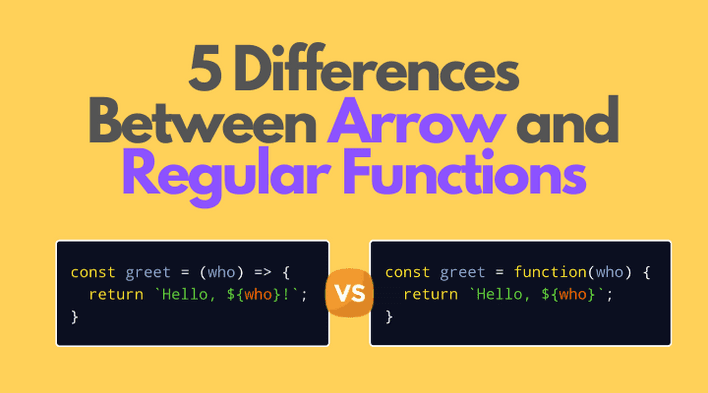You can define JavaScript functions in many ways.
The first, usual way, is by using the function keyword:
// Function declarationfunction greet(who) { return `Hello, ${who}!`;}
// Function expressionconst greet = function(who) { return `Hello, ${who}`;}
The function declaration and function expression I'm going to reference as regular function.
The second way, available starting ES2015, is the arrow function syntax:
const greet = (who) => { return `Hello, ${who}!`;}
While both the regular and arrow syntaxes define functions, when would you use one or another? That's a good question.
In this post, I'll show you the difference between the two, so you could choose the right syntax for your needs.
Table of Contents
1. this value
1.1 Regular function
Inside a regular JavaScript function, this value (aka the execution context) is dynamic.
The dynamic context means that the value of this depends on how the function is invoked. In JavaScript, there are 4 ways you can invoke a regular function.
During a simple invocation the value of this equals the global object (or undefined if the function runs in strict mode):
function myFunction() { console.log(this);}// Simple invocationmyFunction(); // logs global object (window)
During a method invocation the value of this is the object owning the method:
const myObject = { method() { console.log(this); }};// Method invocationmyObject.method(); // logs myObject
During an indirect invocation using myFunc.call(thisVal, arg1, ..., argN) or myFunc.apply(thisVal, [arg1, ..., argN]) the value of this equals to the first argument:
function myFunction() { console.log(this);}const myContext = { value: 'A' };myFunction.call(myContext); // logs { value: 'A' }myFunction.apply(myContext); // logs { value: 'A' }
During a constructor invocation using new keyword this equals the newly created instance:
function MyFunction() { console.log(this);}new MyFunction(); // logs an instance of MyFunction
1.2 Arrow function
The behavior of this inside of an arrow function differs from the regular function's this behavior. The arrow function doesn't define its own execution context but resolves to the one from the outer function.
No matter how or where being executed, this value inside of an arrow function always equals this value from the outer function. In other words, the arrow function resolves this lexically.
In the following example, myMethod() is an outer function of callback() arrow function:
const myObject = { myMethod(items) { console.log(this); // logs myObject const callback = () => { console.log(this); // logs myObject }; items.forEach(callback); }};myObject.myMethod([1, 2, 3]);
this value inside the arrow function callback() equals this of the outer function myMethod().
this resolved lexically is one of the great features of the arrow functions. When using callbacks inside methods you are sure the arrow function doesn't define its own this (no more const self = this or callback.bind(this) workarounds).
Contrary to a regular function, the indirect invocation of an arrow function using myArrowFunc.call(thisVal) or myArrowFunc.apply(thisVal) doesn't change the value of this: the context value always resolves lexically.
2. Constructors
2.1 Regular function
As seen in the previous section, the regular function can easily construct objects.
For example, the new Car() function creates instances of a car:
function Car(color) { this.color = color;}const redCar = new Car('red');redCar instanceof Car; // => true
Car is a regular function. When invoked with new keyword new Car('red') — new instances of Car type are created.
2.2 Arrow function
A consequence of this resolved lexically is that an arrow function cannot be used as a constructor.
If you try to invoke an arrow function prefixed with new keyword, JavaScript throws an error meaning that an arrow function cannot be a constructor.
const Car = (color) => { this.color = color;};const redCar = new Car('red'); // TypeError: Car is not a constructor
Invoking new Car('red'), where Car is an arrow function, throws TypeError: Car is not a constructor.
3. arguments object
3.1 Regular function
Inside the body of a regular function, arguments is a special array-like object containing the list of arguments with which the function has been invoked.
Let's invoke myFunction() function with 2 arguments:
function myFunction() { console.log(arguments);}myFunction('a', 'b'); // logs { 0: 'a', 1: 'b', length: 2 }
Inside of myFunction() body the arguments is an array-like object containing the invocation arguments: 'a' and 'b'.
3.2 Arrow function
On the other side, no arguments special keyword is defined inside an arrow function.
Again (same as with this value), the arguments object is resolved lexically: the arrow function accesses arguments from the outer function.
Let's try to access arguments inside of an arrow function:
function myRegularFunction() { const myArrowFunction = () => { console.log(arguments); } myArrowFunction('c', 'd');}myRegularFunction('a', 'b'); // logs { 0: 'a', 1: 'b', length: 2 }
The arrow function myArrowFunction() is invoked with the arguments 'c', 'd'. Still, inside of its body, arguments object equals the arguments of myRegularFunction() invocation: 'a', 'b'.
If you'd like to access the direct arguments of the arrow function, then you can use the rest parameters feature:
function myRegularFunction() { const myArrowFunction = (...args) => { console.log(args); } myArrowFunction('c', 'd');}myRegularFunction('a', 'b'); // logs ['c', 'd']
...args rest parameter collects the execution arguments of the arrow function into an array: ['c', 'd'].
4. Implicit return
4.1 Regular function
return expression statement returns the result from a function:
function myFunction() { return 42;}myFunction(); // => 42
If the return statement is missing, or there's no expression after the return statement, the regular function implicitly returns undefined:
function myEmptyFunction() { 42;}function myEmptyFunction2() { 42; return;}myEmptyFunction(); // => undefinedmyEmptyFunction2(); // => undefined
4.2 Arrow function
You can return values from the arrow function the same way as from a regular function, but with one useful exception.
If the arrow function contains one expression, and you omit the function's curly braces, then the expression is implicitly returned. These are the inline arrow functions.
const increment = (num) => num + 1;increment(41); // => 42
increment() consists of only one expression: num + 1. This expression is implicitly returned by the arrow function without the use of return keyword.
5. Methods
5.1 Regular function
Regular functions are the usual way to define methods on classes or objects.
In the following class Hero, the method logName() is defined using a regular function:
class Hero { constructor(heroName) { this.heroName = heroName; } logName() { console.log(this.heroName); }}const batman = new Hero('Batman');
Usually, regular functions as methods are the way to go.
Sometimes you'd need to supply the method as a callback, for example to setTimeout() or an event listener. In such cases, you might encounter difficulties accessing this value.
For example, let's use logName() method as a callback to setTimeout():
setTimeout(batman.logName, 1000);// after 1 second logs "undefined"
After 1 second, undefined is logged to console. setTimeout() performs a simple invocation of logName (where this is the global object). That's when the method is separated from the object.
Let's bind this value manually to the right context:
setTimeout(batman.logName.bind(batman), 1000);// after 1 second logs "Batman"
batman.logName.bind(batman) binds this value to batman instance. Now you're sure that the method doesn't lose the context.
Binding this manually requires boilerplate code, especially if you have lots of methods. There's a better way: the arrow functions as a class field.
5.2 Arrow function
Thanks to the class fields feature you can use the arrow function as methods inside classes.
Now, in contrast with regular functions, the method defined using an arrow binds this lexically to the class instance.
Let's use the arrow function as a field:
class Hero { constructor(heroName) { this.heroName = heroName; } logName = () => { console.log(this.heroName); }}const batman = new Hero('Batman');
Now you can use batman.logName as a callback without manual binding of this. The value of this inside logName() method is always the class instance:
setTimeout(batman.logName, 1000);// after 1 second logs "Batman"
6. Summary
Understanding the differences between regular and arrow functions helps choose the right syntax for specific needs.
this value inside a regular function is dynamic and depends on the invocation. But this inside the arrow function is bound lexically and equals to this of the outer function.
arguments object inside the regular functions contains the arguments in an array-like object. The arrow function, on the opposite, doesn't define arguments (but you can easily access the arrow function arguments using a rest parameter ...args).
If the arrow function has one expression, then the expression is returned implicitly, even without using the return keyword.
Last but not least, you can define methods using the arrow function syntax inside classes. Fat arrow methods bind this value to the class instance.
Anyhow the fat arrow method is invoked, this always equals the class instance, which is useful when the methods are used as callbacks.
To understand all types of functions in JavaScript, I recommend checking JavaScript Function Declaration: The 6 Ways.
What other differences between the arrow and regular functions do you know?


